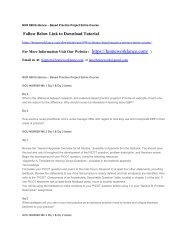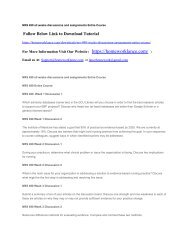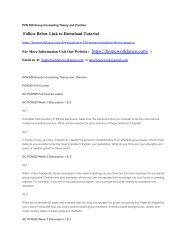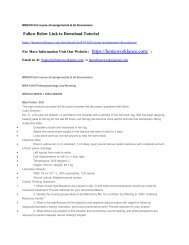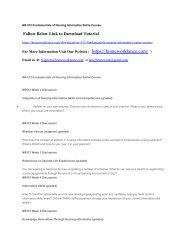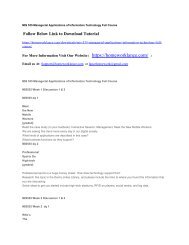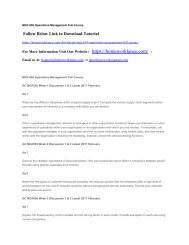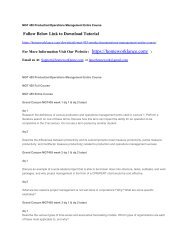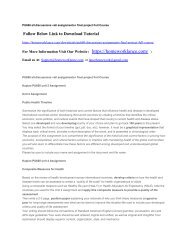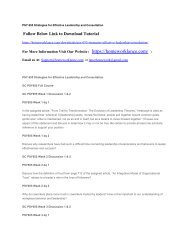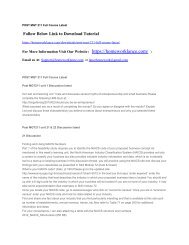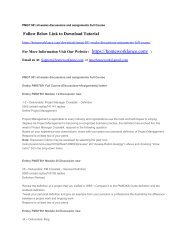NR505 Advanced Research Methods Evidence-Based Practice
Create successful ePaper yourself
Turn your PDF publications into a flip-book with our unique Google optimized e-Paper software.
<strong>NR505</strong> <strong>Advanced</strong> <strong>Research</strong> <strong>Methods</strong>: <strong>Evidence</strong>-<strong>Based</strong> <strong>Practice</strong><br />
Follow Below Link to Download Tutorial<br />
https://homeworklance.com/downloads/nr505-advanced-research-methods-evidence-based-practice/<br />
For More Information Visit Our Website ( https://homeworklance.com/ )<br />
Email us At: Support@homeworklance.com or lancehomework@gmail.com<br />
<strong>NR505</strong> <strong>Advanced</strong> <strong>Research</strong> <strong>Methods</strong>: <strong>Evidence</strong>-<strong>Based</strong> <strong>Practice</strong><br />
NR 505 Full Course<br />
<strong>NR505</strong> week 1 discussion<br />
Write a quantitative research question using the PICO(T) model about a health or safety issue observed in the<br />
Ironridge or Summerville community or your practice setting.Conducta search of the literature for the quantitative<br />
research question. (Remember you can use this topic and quantitative research article as part of your <strong>Research</strong><br />
Summary Table assignment).Provide a brief summary of your quantitative research article.<br />
You will not be able to see other’s posts for this forum until you have posted your response to the threaded<br />
discussion thread.<br />
<strong>NR505</strong> week 2 discussion<br />
Review the differences in predictive and prescriptive studies and select a predictive or prescriptive article that you<br />
found in your literature search. What are the independent variables (IV), dependent variables (DV), and mediating<br />
variables (MVs) that you find in the article? How do determining IVs, DVs, and MVs help you discern the theory<br />
tested in the research? In your particular article, what risk factors are identified, or what recommendations are<br />
provided?<br />
<strong>NR505</strong> week 3 discussion<br />
Plan a Qualitative Study (graded)<br />
Write a qualitative research question using the PICO(T) model using the P (population), I (abstract concept), O<br />
(outcome), and T (time) from the PICO(T) model about an issue from your practice setting.Conduct a search of the<br />
literature for a qualitative research article that would answer your qualitative research question. What qualitative<br />
research design (Phenomenology, Grounded Theory, Ethnography) did you select and why? Provide a summary of<br />
the study. How will you make sure that the information you obtain is trustworthy? How is trustworthiness in qualitative<br />
research similar and different from reliability and validity?<br />
<strong>NR505</strong> week 4 discussion
What are the various types of sampling, along with their advantages and disadvantages? As we think about sampling<br />
and ethical practices, review these two documents on ethical issues in research:<br />
Tuskegee syphilis study at.cdc.gov/tuskegee/”>http://www.cdc.gov/tuskegee/<br />
An overview of questionable studies: Resnik, D. (2012). <strong>Research</strong> ethics timeline (1932-present). Retrieved<br />
from.niehs.nih.gov/research/resources/bioethics/timeline/index.cfm”>http://www.niehs.nih.gov/research/resources/bio<br />
ethics/timeline/index.cfm<br />
What are the implications of this information with respect to the recruitment of human subjects in a study related to<br />
your chosen issue?<br />
<strong>NR505</strong> week 5 discussion<br />
Inferential Statistics (graded)<br />
Complete a PICO(T) search on a topic that pertains to your practice setting. Select one of the articles from your<br />
search. Identify the descriptive statistics. Then describe the inferential tests that were used in the article (in other<br />
words, t-tests and chi-squares). Given the p-values related to the tests, how do you interpret the results? Are they<br />
statistically significant, also clinically significant? What are the recommendations based on this paper? Share some<br />
alternate explanations (mediating or intervening variables) for the results of the study. If your chosen study does not<br />
contain inferential tests, then choose a different article that does contain inferential tests so you can participate in the<br />
discussion.<br />
<strong>NR505</strong> week 6 discussion<br />
<strong>Evidence</strong>-<strong>Based</strong> Models (graded)Read the box above about Mr. Lowell and his facility. As an advanced practice<br />
nurse, you will looking at various evidence based practice models and choosing two of them to compare and contrast<br />
here. After you compare and contrast them, discuss which one you would recommend to this facility and why?<br />
Remember to support your posts with scholarly research in APA 6th ed format.<br />
<strong>NR505</strong> week 7 discussion<br />
Quality, Safety, and Costs (graded)<br />
Class, this week I would like for you to think about a patient scenario related to our Summerville scenario. Mr. Lowell<br />
is especially concerned about a costly high infection rate in surgical patients at St. Louis Medical Center, along with a<br />
lack of concern about patient’s psychological needs. He has read about the efforts of the QSEN Institute<br />
(.org/”>http://qsen.org) to promote quality and safety. He was surprised to see that patient concerns are inherent in<br />
the quality improvement conversation. Place yourself in the role of nurse educator to help the new staff education<br />
director and the clinical practice council study both problems. How would you explain the relationships among quality,<br />
safety, and costs to the director and staff? How would you demonstrate the importance of nursing care in addressing<br />
this issue? What outcome variables would you recommend?<br />
<strong>NR505</strong> week 8 discussion<br />
What specific skills and knowledge that you gained through this course will be most important as you plan and<br />
implement your practicum project? Describe a concrete way in which you anticipate using these skills and knowledge.
<strong>NR505</strong> week 3 <strong>Research</strong> Summary Table<br />
<strong>Research</strong> Summary Table<br />
Guidelines with Scoring Rubric<br />
Purpose<br />
The purpose of this assignment is for the student to learn to assimilate, analyze, critique, and summarize original<br />
research articles. In other words, select a report of a single, original study.<br />
Course Outcomes<br />
Through this assignment, the student will demonstrate the ability to:<br />
(CO 2) Formulate and analyze nursing/clinical problems related to nursing and other disciplines. (PO 1, 2, 4, 6, 7, 8,<br />
9, 10)<br />
(CO 3) Synthesize for dissemination the research findings from nursing and related disciplines. (PO 1, 3, 4, 5, 6, 7, 9,<br />
11)<br />
Due Date:Sunday 11:59 p.m. MT at the end of Week 3<br />
Total Points Possible: 165 Points<br />
Requirements<br />
Through this assignment, the student will<br />
1. 1. Conduct a systematic search of relevant databases to find research-based evidence related to a nursing<br />
problem (CO 2);<br />
2. 2. Construct a summary table of four peer-reviewedquantitative single original studies, indicating the<br />
purpose, sample, design/level of evidence, findings, and limitations of each (CO 3); and<br />
3. 3. Summarize the findings of the four studies as a whole (CO 3).<br />
Preparing the Table<br />
Conduct a PICO(T) search on the nursing problem related to your practice setting.Select the four most recent peerreviewed<br />
studiesthat describe original research in a single study (do not select a meta-analysis, systematic review of<br />
research, or integrative literature review). Refer to the Types of Articles Found in the Nursing and<br />
Healthcaredocument in the Course Resource section to make sure that you are using the correct document.<br />
Construct a table summarizing the four most credible and recent studies, using the <strong>Research</strong> Summary template on<br />
the next page (also found in Course Resource Section). Analyze each article and provide the following information in<br />
brief format: purpose of the study; type of sample and number of participants; design of the study, along with the level<br />
of evidence; findings of the study; and limitations of the study.<br />
Preparing the Summary<br />
Briefly (2-4 pages; not including cover page and reference page(s)) summarize the results of the four studies as a<br />
whole. Follow this outline:<br />
1. I. In a short paragraph, restate your research question and describe your search strategy. (10 points)<br />
2. II. Analysis of the designs used in the studies presented in your research summary table. (10 points)<br />
III. Where do these studies fall on the Levelsof<strong>Evidence</strong> table? What is the significance of this information?(10 points)<br />
1. IV. <strong>Based</strong> on these studies, what are the findings? What is the answer to the research question?How well do<br />
the studies answer or fail to answer the question? Provide rationale to support your answer.(10 points)<br />
2. V. Howwas eachsample selected and how many participants in the studies. Is this number adequate? Why<br />
or why not? (10 points)
3. VI. Overall, what are the limitations of the study, and how can these limitations be overcome in subsequent<br />
studies? (10 points)<br />
VII. <strong>Based</strong> on these findings, is the evidence that you found on your topic strong enough to suggest a change in<br />
practice or an idea for practice? Why or why not?Please provide a rationale for your answer.(10 points)<br />
Provide your references, formatted in APA style, after the summary. Include the doi number for each article. Submit a<br />
permalink of each article you have chosen for this assignment (directions on how to obtain a permalink are located in<br />
the Course Resource section).<br />
Instructions for setting up your paper in APA 6 th edition format.<br />
Look at the example document for this assignment. Start your paper as you would other APA 6 th edition format<br />
professional papers. Copy and paste the table into your APA paper. This should allow your paper to remain in a<br />
vertical format. Your paper should be one document.<br />
<strong>Research</strong> Summary Table (template provided in separate document)<br />
<strong>NR505</strong> week 5 Critique of Systematic <strong>Research</strong><br />
Review<br />
Critique of Systematic <strong>Research</strong> Review (SRR)<br />
Guidelineswith Scoring Rubric<br />
Purpose<br />
The purpose of this assignment is to provide students with practice in identifying, reading, and critiquing systematic<br />
research reviews related to nursing. A systematic review is defined as “A summary of evidence, typically conducted<br />
by an expert or expert panel on a particular topic, that uses a rigorous process (to minimize bias) for identifying,<br />
appraising, and synthesizing studies to answer a specific clinical question and draw conclusions about the data<br />
gathered (Melnyk&Fineout-Overholt,2011, p.582).<br />
Course Outcomes<br />
Through this assignment, the student will demonstrate the ability to<br />
(CO 3) Synthesize for dissemination the research findings from nursing and related disciplines. (PO 1, 3, 4, 5, 6, 7, 9,<br />
11)<br />
(CO 4) Compare and critique quantitative and qualitative designs and methodologies for research studies. (PO 4, 7,<br />
9, 11)<br />
Due Date:Sunday 11:59 p.m. MT at the end of Week 5<br />
Total Points Possible:175 Points<br />
Requirements:<br />
1. 1. Choose an SRR that pertains to your practice setting.Describe the relevance of the nursingresearch<br />
problem addressed in a SRR to practice. (CO 3, 6)<br />
2. 2. Critique the levels of evidence of the studies used in the SRR, specifically the designs of the studies<br />
included. (CO 6)<br />
3. 3. Critique the clarity with which the studies are presented and critiqued. (CO 6)<br />
4. 4. Describe the overall findings of the studies, as summarized in the SRR. (CO 3, 6)<br />
5. 5. Critique the conclusions of the SRR, with implications for your current practice andfuture research. (CO 3,<br />
6)<br />
6. 6. Utilize the Cochrane Database of Systematic Reviews to locate a true SRR for this assignment.<br />
7. 7. Paper length should be between 4-6 pages (not including cover page and reference page(s).<br />
Preparing the paper
Consult your faculty member if you are uncertain about whether your article is a true SRR. If it is not, your grade will<br />
be affected because you will not be able to address all of the above objectives.<br />
Important: Submit a copy of the systematic research review that you are critiquing as a separate document<br />
before submitting your paper.This will help Turnitin from returning a high similarity percentage on your<br />
written work. Remember to keep Turnitin similarity to 24% or less or you will be deducted points on APA.<br />
References<br />
Melnyk, B.M., &Fineout-Overholt, E. (2011).<strong>Evidence</strong>-based practice in nursing &healthcare(2 nd ed.). Philadelphia,<br />
PA: Wolters Kluwer/Lippincott, Williams,& Wilkins.<br />
Turnitin®<br />
This assignment will be submitted to Turnitin.You learned about Turnitin in your NR500 course, so you should be<br />
familiar with how to access it. Additionally, you will find an instructional announcement about Turnitin® in the course<br />
and in the Student Handbook.<br />
Category Points% Description<br />
Describes the<br />
Fully describes<br />
relevance of the<br />
the relevance of<br />
research problem 25 14.28<br />
the research<br />
addressed in the<br />
problem<br />
SRR to practice.<br />
Critiques the<br />
research rigor of<br />
Fully critiques the<br />
the studies used in<br />
rigor of the<br />
25 14.28<br />
the SRR (see<br />
studies used in<br />
lesson’s levels of<br />
the SRR<br />
evidence).<br />
Critiques the<br />
levels of evidence,<br />
specifically the<br />
designs of the<br />
studies included in<br />
the SRR.<br />
Critiques the<br />
clarity with which<br />
Fully critiques the<br />
levels of<br />
25 14.28evidence of the<br />
studies included<br />
in the SRR<br />
Fully describes<br />
the clarity with<br />
the studies are<br />
presented and<br />
critiqued.<br />
25 14.28which the studies<br />
are presented<br />
and critiqued<br />
Fully describes<br />
Describes the<br />
the overall<br />
overall findings of<br />
findings of the<br />
the studies, as 25 14.28<br />
studies<br />
summarized in the<br />
summarized in<br />
SRR.<br />
the SRR<br />
Critiques the<br />
Critiques the<br />
conclusions of the<br />
conclusions of<br />
SRR, with<br />
the SRR, with<br />
implications for 25 14.28implications for<br />
your current<br />
current<br />
practice and future<br />
practiceandfuture<br />
research<br />
research
Grammar,<br />
punctuation, and<br />
spelling reflect<br />
format written<br />
work.<br />
10 5.71<br />
APA formatting 10 5.71<br />
Submit a copy of<br />
the systematic<br />
research article<br />
5 2.85<br />
you are critiquing.<br />
Grammar,<br />
spelling, word<br />
usage, and<br />
punctuation are<br />
consistent with<br />
rules for formal<br />
written work.<br />
APA formatting is<br />
correct<br />
Submits a copy<br />
of the permalink<br />
of the systematic<br />
research article<br />
that you are<br />
critiquing<br />
A quality<br />
assignment will<br />
175 100% meet or exceed<br />
all of the above<br />
requirements.<br />
<strong>NR505</strong> Analysis and Application of Clinical <strong>Practice</strong><br />
<br />
Analysis and Application of Clinical<br />
<strong>Practice</strong> Guidelines & Scoring Rubric<br />
Purpose<br />
The purpose of this assignment is to provide an opportunity for students to apply and disseminate information based<br />
on practice summaries. The most common type of practice summary in healthcare is the clinical practice guideline<br />
(CPG).<br />
Course Outcomes<br />
Through this assignment, the student will demonstrate the ability to<br />
(CO 3) Synthesize for dissemination the research findings from nursing and related disciplines (POs 1, 3, 4, 5, 9); and<br />
(CO 6) Utilize the principles of evidence-based practice to propose strategies that can address nursing issues (POs<br />
1, 3, 4, 5, 7, 9).<br />
Due Date:Sunday 11:59 p.m. MT at the end of Week 7<br />
Total Points Possible:200 Points<br />
Requirements:<br />
Through this assignment, the student will<br />
Develop summary of a clinical practice guideline. (COs 3, 6)<br />
Preparing the paper<br />
You will develop a summary that you could use within an evidence-basedpractice (EBP) committee or related venue<br />
to share with your colleagues. This paper will be 2-4 pages in length.<br />
Select a clinical practice guidelines that addresses an issue pertinent to your practice setting.
Search the literature and evidence-based practice websites and databases to find a recent clinical practice<br />
guideline (no more than 5 years) related to the issue you select. The course Webliography provides websites where<br />
you can find clinical practice guidelines, but there are many others available in specialty-organization websites.<br />
Analyze and critique the clinical practice guideline. Use the Clinical <strong>Practice</strong> Guideline Summary Template in<br />
Course Resources to develop your paper. Components include:<br />
o scope and purpose of the clinical practice guidelines;<br />
o stakeholder involvement;<br />
o rigor of development;<br />
o clarity and presentation<br />
o applicability<br />
o editorial independence<br />
Attach URL address of the Clinical <strong>Practice</strong> Guidelines on the reference page of your paper.<br />
Note: Thetemplate isan outline to assist you in setting up your paper so you will be sure to address those<br />
topics in your paper in addition to other information to meet the criteria for this assignment. Your paper should be in<br />
APA 6th ed format. Do not copy and paste the template into your paper.<br />
The summary sheetis amended from the AGREE instrument on page 200 of Melnyk & Fineout-Overholt (2015). Your<br />
summaryshould be approximately 5–6 pages long (Paper lengths do not include cover page or reference page(s).<br />
Category Points% Description<br />
Describes the<br />
scope and<br />
purpose of the<br />
document.<br />
Scope and Purpose 25 12.5<br />
Includes the<br />
health question(s)<br />
covered by the<br />
guideline<br />
Describes the<br />
stakeholder<br />
involvement in<br />
Stakeholder<br />
25 12.5 the development<br />
Involvement<br />
of the document.<br />
Identifies the<br />
target population.<br />
Critiques the rigor<br />
of the<br />
development of<br />
the document.<br />
Describes the<br />
systematic<br />
Rigor of<br />
25 12.5 methods used to<br />
Development<br />
develop the<br />
guideline. Include<br />
level of evidence<br />
of the studies<br />
used to develop<br />
the guideline.<br />
Clarity & 25 12.5 Provides thekey
presentation<br />
(Recommendations)<br />
recommendations<br />
of the document.<br />
Discusses<br />
different options<br />
for managing the<br />
condition or issue<br />
in the guideline.<br />
Application 25 12.5<br />
Identifies<br />
facilitators,<br />
barriers, costs,<br />
and outcome<br />
measurement for<br />
application of the<br />
document..<br />
Identifies key<br />
monitoring and/or<br />
auditing criteria<br />
(outcomes)<br />
Discusses conflict<br />
of interest and<br />
how competing<br />
Editorial<br />
interests of the<br />
25 12.5<br />
Independence<br />
CPG group<br />
members<br />
recorded and<br />
addressed.<br />
Summarizes how<br />
the CPG answers<br />
the key clinical<br />
questions<br />
presented in the<br />
Summary 25 12.5 CPG. Discusses<br />
how the student,<br />
as the advanced<br />
practice nurse,<br />
would apply the<br />
CPG in practice.<br />
No more than 2<br />
Uses appropriate<br />
errors in<br />
grammar, syntax, 10 5<br />
grammar, syntax,<br />
and spelling<br />
or spelling.<br />
No more than 2<br />
APA 6 th Edition 10 5 APA 6 th edition<br />
errors.<br />
A pdf copy of the<br />
Attach pdf file of the<br />
Clinical <strong>Practice</strong><br />
Clinical <strong>Practice</strong> 5 2.5<br />
Guidelines<br />
Guidelines<br />
submitted.
Total 200<br />
A quality<br />
assignment will<br />
100% meet or exceed<br />
all of the above<br />
requirements.<br />
Grading Rubric<br />
Needs<br />
Exceptional Exceeds Meets<br />
Developing<br />
Improvement<br />
(100%) (88%)<br />
(80%)<br />
(0)<br />
(38%)<br />
Assignment Criteria Outstanding or Very good or high Competent or<br />
Unsatisfactory<br />
Poor or failing<br />
highest level of level of<br />
satisfactory level<br />
level of<br />
level of<br />
performance performance of performance<br />
performance<br />
performance<br />
ContentPossible<br />
Points = 175 Points<br />
Scope and Purpose 25 Points 22 Points 20Points 10 Points 0 Points<br />
Describes the Describes the<br />
Describes the scope<br />
Does not include<br />
scope and scope and<br />
and purpose of the<br />
Weakly describes the scope or<br />
purpose of the purpose of the<br />
document. Includes<br />
the scope and purpose of the<br />
document but has document with a<br />
the health question(s)<br />
purpose of the health question<br />
occasional minimal amount of<br />
covered by the<br />
document. covered by the<br />
missing information<br />
guideline<br />
guideline.<br />
information. presented.<br />
Stakeholder<br />
Involvement<br />
25 Points 22 Points 20Points 10 Points 0 Points<br />
Does not Does not<br />
Describes the Describes the<br />
describe the describe the<br />
Describes all of the stakeholder stakeholder<br />
stakeholder stakeholder<br />
stakeholders involvement in involvement in the<br />
involvement in involvement in<br />
involvement in the the development development of<br />
the development the development<br />
development of the of the document the document with<br />
of the document of the document<br />
document. Identifies with occasional a minimal amount<br />
OR does not AND does not<br />
the target population information of information<br />
identify the target identify the target<br />
missing. presented.<br />
population. population.<br />
Rigor of<br />
Development<br />
25 Points 22 Points 20Points 10 Points 0 Points<br />
Critiques the rigor of Critiques the rigor Critiques the rigor Does not critique Does not critique<br />
the development of<br />
the document.<br />
Describes the<br />
systematic methods<br />
used to develop the<br />
of the<br />
development of<br />
the document.<br />
Describes the<br />
systematic<br />
of the<br />
development of<br />
the document.<br />
Describes the<br />
systematic<br />
the rigor of the<br />
development of<br />
the document.<br />
Does not<br />
describe the<br />
the rigor of the<br />
development of<br />
the document.<br />
Does not<br />
describe the<br />
guideline. Includes methods used to methods used to systematic systematic<br />
level of evidence of develop the develop the methods used to methods used to<br />
the studies used to guideline. guideline. Includes develop the develop the<br />
develop the Includes the the levels of guideline. guideline.<br />
guidelines. levels of evidence evidence of the ORDoes not ANDDoes not<br />
Elaborates on rigor of of the studies studies used to include the levels include the levels<br />
development. used to develop develop the of evidence of the of evidence of the
the guidelines. guidelines. studies used to studies used to<br />
Some occasional Provides a develop the develop the<br />
important minimal amount of guidelines. guidelines.<br />
information is<br />
missing.<br />
information.<br />
Clarity &<br />
Presentation 25 Points 22 Points 20Points 10 Points 0 Points<br />
(Recommendations)<br />
Provides thekey<br />
Provides thekey<br />
Provides theall key<br />
recommendations Does not provide Does not provide<br />
recommendations<br />
recommendations of<br />
of the document. or provide thekey or provide thekey<br />
of the document.<br />
the document.<br />
Discusses recommendations recommendations<br />
Discusses<br />
Discusses different<br />
different options of the document. of the document.<br />
different options<br />
options for managing<br />
for managing the ORDoes not ANDDoes not<br />
for managing the<br />
the condition or issue<br />
condition or issue discuss different discuss different<br />
condition or issue<br />
addressed in the<br />
addressed in the options for options for<br />
addressed in the<br />
guideline. Elaborates<br />
guideline. Briefly managing the managing the<br />
guideline. Missing<br />
on the clarity and<br />
elaborates on the condition or issue condition or issue<br />
some occasional<br />
presentation of the<br />
clarity and addressed in the addressed in the<br />
important<br />
recommendations.<br />
presentation of the guideline. guideline.<br />
information.<br />
recommendations.<br />
Application 25 Points 22 Points 20Points 10 Points 0 Points<br />
Identifies<br />
facilitators,<br />
Does not<br />
Does not Identify<br />
barriers (real or Briefly Identifies<br />
Identifies<br />
facilitators,<br />
Identifies facilitators, potential), costs, facilitators,<br />
facilitators,<br />
barriers (real or<br />
barriers (real or and outcome barriers (real or<br />
barriers (real or<br />
potential), costs,<br />
potential), costs, and measurement for potential), costs,<br />
potential), costs,<br />
and outcome<br />
outcome<br />
application of the and outcome<br />
and outcome<br />
measurement for<br />
measurement for document. measurement for<br />
measurement for<br />
application of the<br />
application of the Identifies key application of the<br />
application of the<br />
document.<br />
document. Identifies monitoring or document.<br />
document.<br />
ORDoes not<br />
key monitoring or auditing criteria Identifies key<br />
ANDDoes not<br />
identify key<br />
auditing criteria (outcomes). monitoring or<br />
identify key<br />
monitoring or<br />
(outcomes). Some occasional auditing criteria<br />
monitoring or<br />
auditing criteria<br />
important (outcomes).<br />
auditing criteria<br />
(outcomes).<br />
information is<br />
(outcomes).<br />
missing.<br />
Editorial<br />
Independence<br />
25 Points 22 Points 20Points 10 Points 0 Points<br />
Discusses conflict Discusses conflict Briefly discusses Does not discuss Does not<br />
of interest of of interest of<br />
group members. group members.<br />
Discusses how Discusses how<br />
competing competing<br />
interests of the interests of the<br />
CPG group CPG group<br />
members are members are<br />
conflict of interest conflict of interest discuss conflict<br />
of group of group<br />
members. Briefly members. Does<br />
discusses how not discuss how<br />
competing competing<br />
interests of the interests of the<br />
CPG group CPG group<br />
of interest of<br />
group<br />
members.<br />
Does not<br />
discuss how<br />
competing
ecorded and recorded and<br />
addressed. addressed.<br />
Addresses how Addresses how<br />
the views of the the views of the<br />
funding body are funding body are<br />
kept from kept from<br />
influencing the influencing the<br />
content of the content of the<br />
guideline. guideline. Some<br />
occasional<br />
important<br />
information is<br />
missing.<br />
members are members are<br />
recorded and recorded and<br />
interests of the<br />
CPG group<br />
addressed. Briefly addressed. members are<br />
addresses how ORDoes not recorded and<br />
the views of the address how the addressed.<br />
funding body are views of the AND<br />
kept from funding body are Does not<br />
influencing the<br />
content of the<br />
guideline.<br />
kept from<br />
influencing the<br />
content of the<br />
address how<br />
the views of the<br />
funding body<br />
guideline. are kept from<br />
influencing the<br />
content of the<br />
guideline.<br />
Summary 25 Points 22 Points 20Points 10 Points 0 Points<br />
Does not<br />
summarize the<br />
Summarizes the Summarizes the<br />
Briefly<br />
Does not paper. Does<br />
paper. Discusses paper. Discusses<br />
summarizes the summarize the not discuss<br />
whether or not whether or not the<br />
paper. Briefly paper. Does not whether or not<br />
the CPG answers CPG answers the<br />
discusses discuss whether the CPG<br />
the key clinical key clinical<br />
whether or not or not the CPG answers the<br />
question(s) question(s)<br />
the CPG answers answers the key key clinical<br />
presented in the presented in the<br />
the key clinical clinical<br />
question(s)<br />
CPG and CPG. Discusses<br />
question(s) question(s) presented in<br />
elaborates. how the student,<br />
presented in the presented in the the<br />
Discusses how as the advance<br />
CPG. Briefly CPG. ORDoes CPG.ANDDoes<br />
the student, as practice nurse, will<br />
discusses how not discuss how not discuss<br />
the advance apply the CPG in<br />
the student, as the student, as how the<br />
practice nurse, practice. Some<br />
the advance the advance student, as the<br />
will apply the occasional<br />
practice nurse, practice nurse, advance<br />
CPG in practice important<br />
will apply the will apply the practice nurse,<br />
with specific information is<br />
CPG in practice. CPG in practice. will apply the<br />
examples. missing.<br />
CPG in<br />
practice.<br />
Content<br />
Subtotal____/175<br />
points<br />
FormatPossible<br />
Points = 25 Points<br />
Uses appropriate<br />
grammar, syntax, 10Points 9 Points 8 Points 4 Points 0 Points<br />
and spelling<br />
No errors in 1-2 errors in 3-4 errors in 5 or more errors 6 or more errors<br />
grammar, syntax, or grammar, syntax, grammar, syntax, in grammar, in grammar,<br />
spelling<br />
or spelling or spelling syntax, or spellingsyntax, or spelling<br />
APA 6 th edition 10Points 9 Points 8 Points 4 Points 0 Points<br />
No APA 6 th edition 1-2 APA 3-4 APA 6 th edition 5 APA 6 th edition 6 or more APA
errors 6 th edition errors errors errors 6 th edition<br />
errorsORTurnitin<br />
similarity<br />
percentage on<br />
student written<br />
work is higher<br />
than 24%.<br />
Attach pdf copy of<br />
the Clinical <strong>Practice</strong> 5 Points 0 Points<br />
Guideline<br />
No pdf file of the<br />
Pdf file of the Clinical<br />
Clinical <strong>Practice</strong><br />
<strong>Practice</strong> Guideline<br />
Guideline<br />
attached<br />
attached<br />
Format<br />
Subtotal____/25<br />
points<br />
Total<br />
Points_____/200<br />
points



